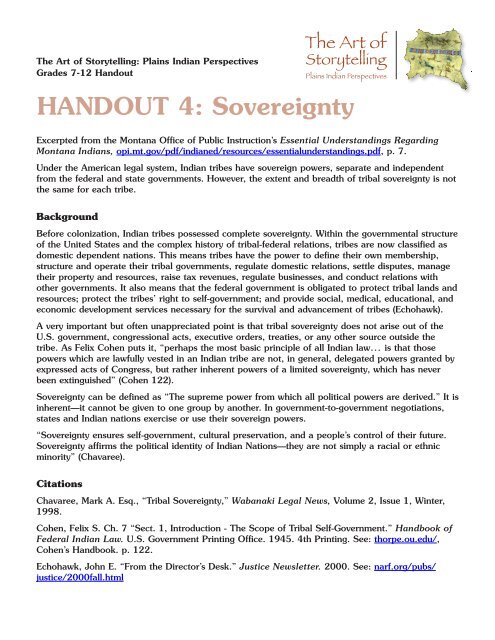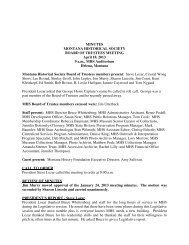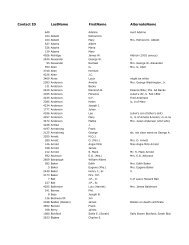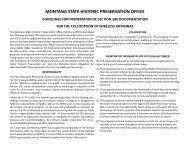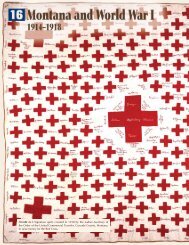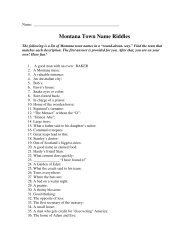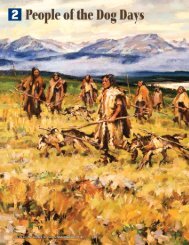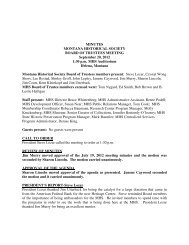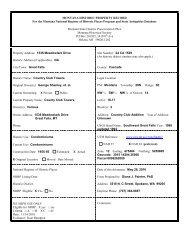Grades 7–12 - Montana Historical Society
Grades 7–12 - Montana Historical Society
Grades 7–12 - Montana Historical Society
You also want an ePaper? Increase the reach of your titles
YUMPU automatically turns print PDFs into web optimized ePapers that Google loves.
The Art of Storytelling: Plains Indian Perspectives<br />
<strong>Grades</strong> 7-12 Handout<br />
HAndouT 4: Sovereignty<br />
Excerpted from the <strong>Montana</strong> Office of Public Instruction’s Essential Understandings Regarding<br />
<strong>Montana</strong> Indians, opi.mt.gov/pdf/indianed/resources/essentialunderstandings.pdf, p. 7.<br />
Under the American legal system, Indian tribes have sovereign powers, separate and independent<br />
from the federal and state governments. However, the extent and breadth of tribal sovereignty is not<br />
the same for each tribe.<br />
Background<br />
Before colonization, Indian tribes possessed complete sovereignty. Within the governmental structure<br />
of the United States and the complex history of tribal-federal relations, tribes are now classified as<br />
domestic dependent nations. This means tribes have the power to define their own membership,<br />
structure and operate their tribal governments, regulate domestic relations, settle disputes, manage<br />
their property and resources, raise tax revenues, regulate businesses, and conduct relations with<br />
other governments. It also means that the federal government is obligated to protect tribal lands and<br />
resources; protect the tribes’ right to self-government; and provide social, medical, educational, and<br />
economic development services necessary for the survival and advancement of tribes (Echohawk).<br />
A very important but often unappreciated point is that tribal sovereignty does not arise out of the<br />
U.S. government, congressional acts, executive orders, treaties, or any other source outside the<br />
tribe. As Felix Cohen puts it, “perhaps the most basic principle of all Indian law... is that those<br />
powers which are lawfully vested in an Indian tribe are not, in general, delegated powers granted by<br />
expressed acts of Congress, but rather inherent powers of a limited sovereignty, which has never<br />
been extinguished” (Cohen 122).<br />
Sovereignty can be defined as “The supreme power from which all political powers are derived.” It is<br />
inherent—it cannot be given to one group by another. In government-to-government negotiations,<br />
states and Indian nations exercise or use their sovereign powers.<br />
“Sovereignty ensures self-government, cultural preservation, and a people’s control of their future.<br />
Sovereignty affirms the political identity of Indian Nations—they are not simply a racial or ethnic<br />
minority” (Chavaree).<br />
Citations<br />
Chavaree, Mark A. Esq., “Tribal Sovereignty,” Wabanaki Legal News, Volume 2, Issue 1, Winter,<br />
1998.<br />
Cohen, Felix S. Ch. 7 “Sect. 1, Introduction - The Scope of Tribal Self-Government.” Handbook of<br />
Federal Indian Law. U.S. Government Printing Office. 1945. 4th Printing. See: thorpe.ou.edu/,<br />
Cohen’s Handbook. p. 122.<br />
Echohawk, John E. “From the Director’s Desk.” Justice Newsletter. 2000. See: narf.org/pubs/<br />
justice/2000fall.html<br />
— 10 —<br />
The Art of<br />
Storytelling<br />
Plains Indian Perspectives


